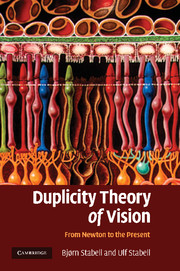Book contents
- Frontmatter
- Contents
- Acknowledgements
- 1 Introduction
- Part I The development of the basic ideas of the duplicity theory from Newton to G. E. Müller
- Part II The development of the duplicity theory from 1930–1966
- 6 The duplicity theory of Polyak
- 7 Investigations of H.K. Hartline and S.W. Kuffler
- 8 The duplicity theory of R. Granit
- 9 Contributions of E.N. Willmer, P. Saugstad & A. Saugstad, and I. Lie
- 10 Status of the duplicity theory in the mid 1960s and its further development
- Part III Chromatic rod vision: a historical account
- Part IV Theories of sensitivity regulation of the rod and cone systems: a historical account
- Part V Factors that triggered the paradigm shifts in the development of the duplicity theory
- References
- Index
6 - The duplicity theory of Polyak
Published online by Cambridge University Press: 22 January 2010
- Frontmatter
- Contents
- Acknowledgements
- 1 Introduction
- Part I The development of the basic ideas of the duplicity theory from Newton to G. E. Müller
- Part II The development of the duplicity theory from 1930–1966
- 6 The duplicity theory of Polyak
- 7 Investigations of H.K. Hartline and S.W. Kuffler
- 8 The duplicity theory of R. Granit
- 9 Contributions of E.N. Willmer, P. Saugstad & A. Saugstad, and I. Lie
- 10 Status of the duplicity theory in the mid 1960s and its further development
- Part III Chromatic rod vision: a historical account
- Part IV Theories of sensitivity regulation of the rod and cone systems: a historical account
- Part V Factors that triggered the paradigm shifts in the development of the duplicity theory
- References
- Index
Summary
After a comprehensive review of the anatomical and histological research on the organs of vision from the classical antiquity to his own time, Polyak (1941) concluded that this research had played a relatively insignificant role in forming hypotheses and theories of the function of the visual system. A major reason was that the retina of humans and other primates had never been examined in any detail by analytical histological methods such as those of Golgi and Ehrlich. These methods, although very time consuming, were preferable, since they permitted the staining of only a few nerve cells at a time from the bewildering mass of tissues. Indeed, in successfully treated preparations, the individual neurons could be stained completely, revealing the whole nerve cell with all its extensions and branches extending as far as the finest terminals. Furthermore, he held that a disclosure of the structural details of the retina of primates would make possible interpretations related to the many psychophysical functions already established in humans.
Polyak, therefore, completed a very impressive histological investigation on the retina of macaques and chimpanzees, using the Golgi method. He also occasionally used retinas from humans. His comprehensive and seminal research work (summarized in 1941; second impression,1948) has long been recognized as a classic contribution to our knowledge of the retinal structure and function in primates.
- Type
- Chapter
- Information
- Duplicity Theory of VisionFrom Newton to the Present, pp. 62 - 71Publisher: Cambridge University PressPrint publication year: 2009



